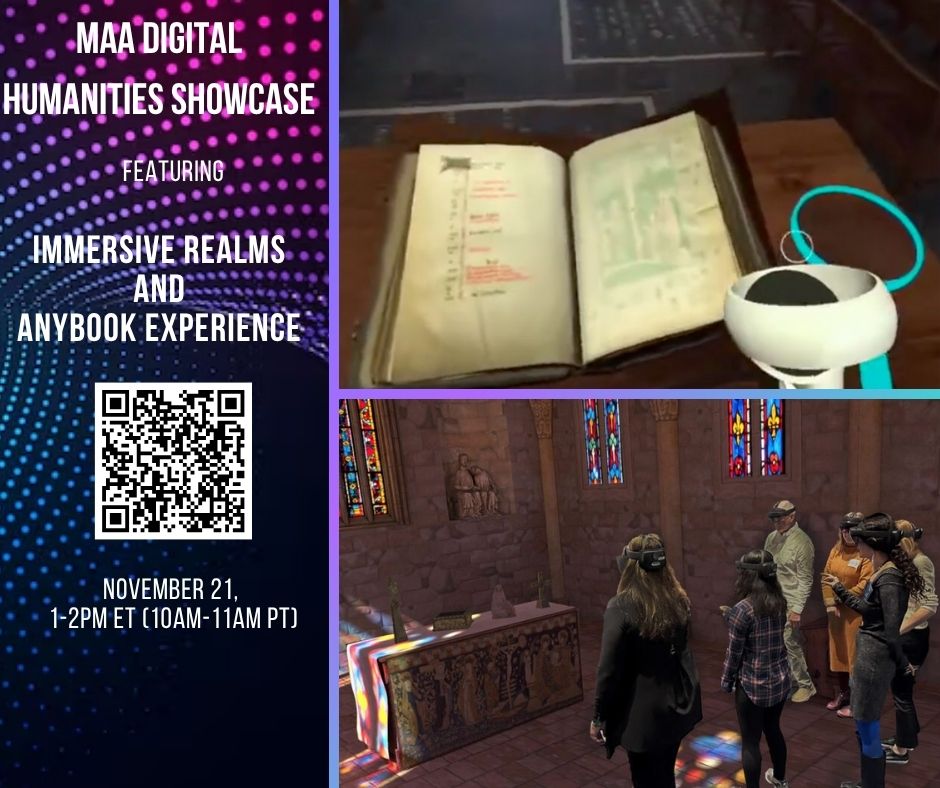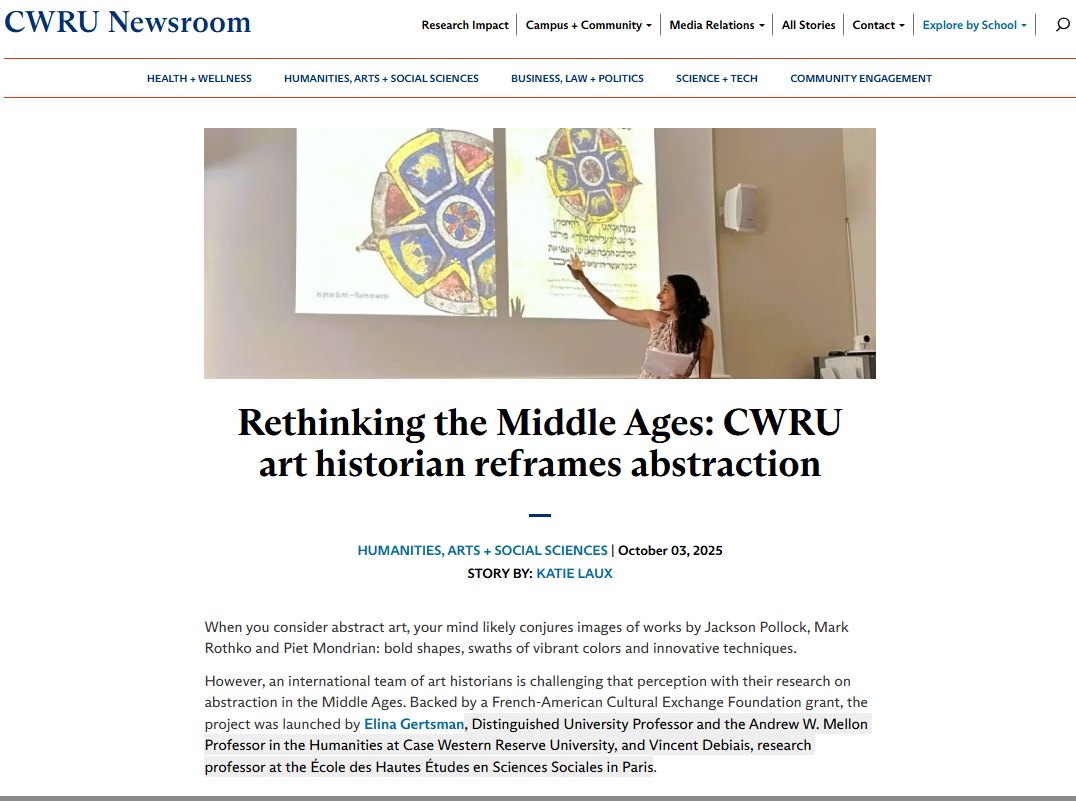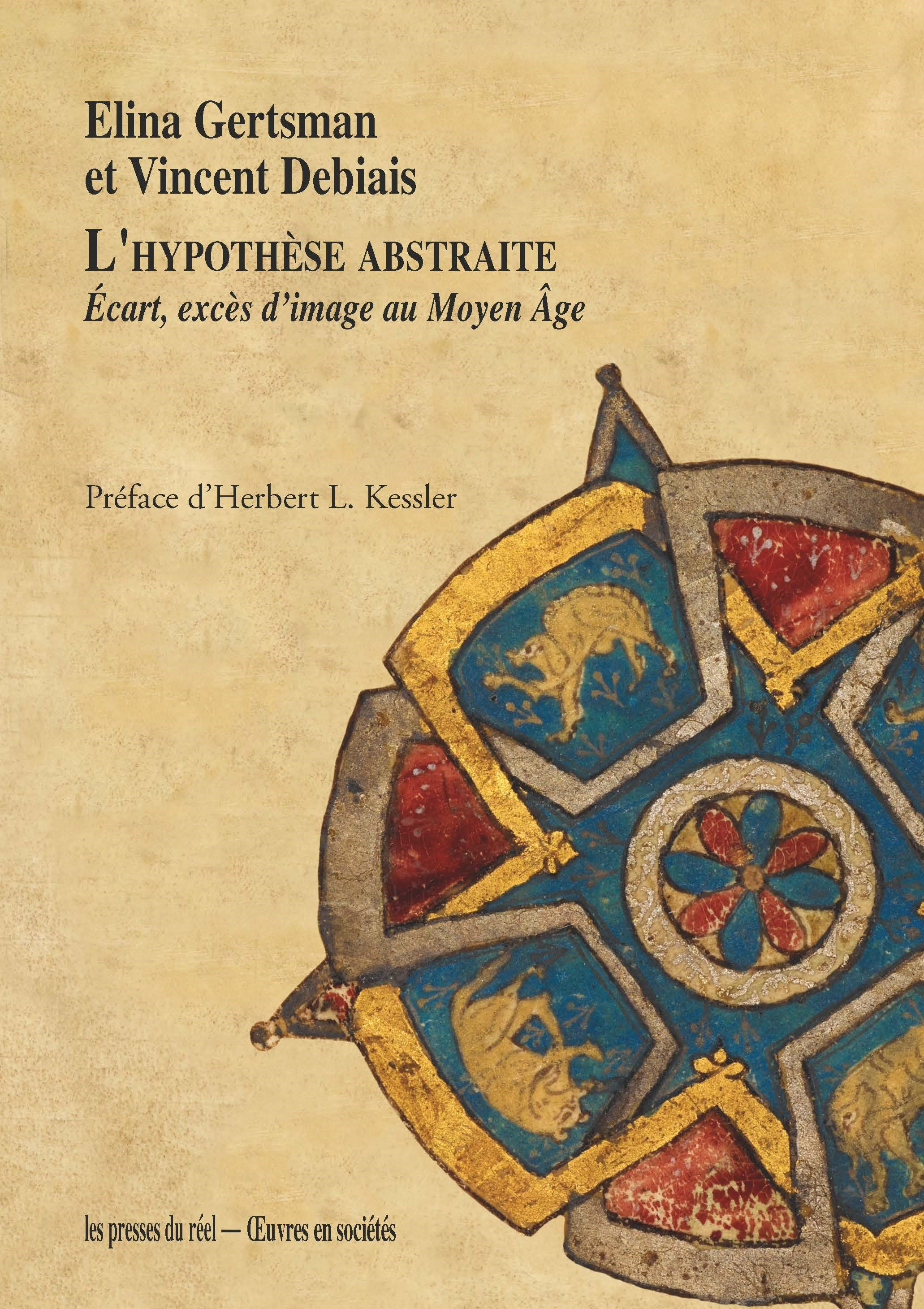Faculty News
Congratuations to Art Studio instructor Adriel Meyer was recently awarded OAEA Outstanding Art Teacher Award at the OAEA annual conference in Columbus, Ohio.
If you have never stopped to examine this exquisitely wrought citrine cameo of Philip II in Gallery 118 at the Cleveland Museum of Art, there is now added reason to do so--it is the subject of Prof. Erin Benay's new article, published in Artibus et Historiae! Special thanks to...
Please join us for the Digital Humanities Showcase on November 21, at 1 pm, for a presentation/discussion of Prof. Elina Gertsman’s Immersive Realms project, followed by the AnyBook Experience project helmed by Sabina Zonno and Lynn Dodd at USC! As part of the celebrations for the MAA’s Centennial Year, the Digital Humanities and Multimedia Studies Committee and the Graduate Student Committee have partnered to organize a year-long series of webinars showcasing exciting DH projects. Register here or use the QR code on the flyer.
The groundbreaking work of Prof. Elina Gertsman, Distinguished University Professor and the Andrew W. Mellon Professor in the Humanities, and her colleague and co-author, Vincent Debiais, Research Professor at the École des Hautes Études en Sciences Sociales in Paris, was featured in The Daily. Read here about their collaboration and about the integral role their graduate students played in this international multidisciplinary project!
Please join us in congratulating Professor Elina Gertsman, Distinguished University Professor and Andrew W. Mellon Professor in the Humanities, on the publication of L’hypothèse abstraite – Écart, excès d’image au Moyen Âge, co-authored with Dr. Vincent Debiais (EHESS)! The book is the culmination of their collaborative project on abstraction in medieval art, which had its genesis in the French-American Cultural Exchange Foundation grant, and resulted in a series of publications, workshops, and symposia held on both sides of the Atlantic. L’hypothèse abstraite explores abstraction as a mode of representation in medieval images that seek to figure unrepresentable truths. Its focus is on the intellectual process of abstraction as the means of accessing knowledge that lies beyond the senses and trips up operations of cognition and perception. The book does not posit medieval abstraction as a reaction to figuration; on the contrary, abstraction is seen as the driving force of figuration, which emphasizes the effects of representation and establishes the image as an image. It is the testimony to a visual process that frees itself from mimesis in favor of a poetics of the gap, engaging with the world that is complex and subtle — the process that undermines the fragile equivalences between what we see and what we know. The preface to the book was authored by Herbert L. Kessler. Read excerpts here.
Just two more weeks to see Prof. Elina Gertsman’s and Dr. Gerhard Lutz’s Creation, Birth, and Rebirth show, which was a central feature in this issue of art/sci magazine, and was reviewed in the print version of Plain Dealer and on cleveland.com. The feature highlights the collaboration between the program and the museum, as well as the role of graduate students in the making of the show and writing its didactics. The magazine, in its new online format, further links to the December interview with Prof. Maggie Popkin about the NEH Public Scholars award given in support of her new book on souvenirs, and announces international symposia convened by Prof. Elizabeth Bolman and Reed O’Mara.
2026 International Congress on Medieval Studies
May 14 – 16, 2026 | Kalamazoo, MI
Organizers: Elina Gertsman (Case Western Reserve) and Nikki DeLuca (University of Vermont)
Cherubim of the Ark, Nicanor’s Gates, the Grail, the reliquary of Sainte Foy: metal objects, real and imaginary, imbued with magic or channeling the miraculous, haunt the long history of medieval art. This session seeks to inquire into material significance of metals, and we invite papers that explore a broad array of themes knotted around their physical and allegorical properties. Topics may include but are not limited to semiotics of metal artefacts; metaphysics of metals; metal’s material relationship with other substances, such as earth or stone; metal visualized in other media; metals and alchemy; metals and cosmology; metals and the supernatural; and metals in prophetic and eschatological discourses. Interdisciplinary approaches are welcome, but the heart of the session lies in its focus on the visual universe of metals manifested as objects: extant, described, or evoked.
Submit your abstract by September 15 here!
The multi-year international joint project, Abstraction Before the Age of Abstract Art, spearheaded by Prof. Elina Gertsman and Prof. Vincent Debiais (École des hautes études en sciences sociales | EHESS), saw its latest event in Paris with the lecture delivered by Prof. Gertsman on abstraction in medieval Sephardic haggadot. The project, which began with the support of the French-American Cultural Exchange Foundation grant, and was picked up last year as part of the collaborative series at the Institut national d’histoire de l’art, took graduate students to both sides of the Atlantic to attend and participate in workshops and symposia in Cleveland and Paris, as well as in the conferences co-organized by Gertsman and Debiais at Princeton University and EHESS.
Tracing Jewish Histories blog post is now live! In addition to a detailed description of the Courtauld conference, it contains a link to recordings of both days of talks. Read it here! Once again, congratulations to Reed on organizing this fantastic endeavor and to Sam, Claudia, Sarah, Tess, Darren, and Alli for chairing and moderating!
This course will explore developments in medieval Japanese art, starting with the rise of cloistered imperial rule in the eleventh century and ending in the sixteenth century with the violent upheaval of the Sengoku era. From the expressive formations of wood sculpture, to the flowing brushwork of ink painting, and the crackling surfaces of tea ware, students will consider how visual culture embodied this dynamic period in Japanese history. We will begin with an introduction to major historical and cultural movements in Japan’s middle ages, considering the impact of art across social strata. Subsequent class sessions will delve into central themes that shape contemporary understandings of medieval art, including intercultural exchange, materiality and the natural world, and intersections of healing and image-making practices.
Scholars and curators of medieval and early modern Jewish art, museology, and provenance convened in London two weeks ago to participate in the international two-day symposium Tracing Jewish Histories: The Long Lives of Medieval Hebrew Manuscripts, Judaica, and Architecture. The symposium took place in London at The Courtauld Institute of Art and was co-organized by Reed O’Mara (Mellon Fellow and PhD candidate at CWRU) and Laura Feigen (PhD candidate at The Courtauld). As a part of the program, speakers were invited to handle Judaica from the collection of the Victoria & Albert Museum with V&A curator Alice Minter. The symposium covered a wide array of subjects, from synagogue architecture to manuscript illumination to the curation and collecting of Judaica, uncovering the complex histories of studying historic Jewish objects and spaces. CWRU and Courtauld graduate students took on roles as chairs and moderators for sessions, and Professor Elina Gertsman served as the primary advisor to Reed and Laura throughout the course of their symposium planning. The symposium was sponsored by the Department of Art History and Art at CWRU, Sam Fogg, the Mellon Foundation, and The Medieval Academy of America Graduate Student Committee Grant for Innovation in Community Building and Professionalization. A recording of the symposium will go live on The Courtauld’s website in the next week!
It was a true privilege to shepherd the department during this academic year. Despite all the complexities, we have accomplished astonishing things! Both our faculty members and our graduate students garnered extremely competitive fellowships and awards, organized international conferences, spoke at a broad variety of venues, published widely, and curated exhibitions. Our studio artists, in turn, exhibited their work across the United States. Our lecture series brought extraordinary scholars to campus; the Graduate Association for Medieval Studies and the Undergraduate Art History Club held a series of fabulous events; and the Cleveland Symposium, which celebrated its 50th anniversary, was a rousing success.










